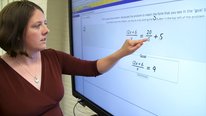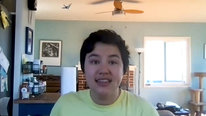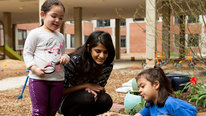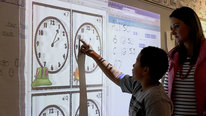- Mathew Felton-Koestler
- https://www.ohio.edu/education/felton
- Associate Professor
- Presenter’s NSFRESOURCECENTERS
- Ohio University
- Courtney Koestler
- https://www.ohio.edu/education/ocems
- Director of OCEMS
- Presenter’s NSFRESOURCECENTERS
- Ohio University
- Amanda Sugimoto
- Assistant Professor
- Presenter’s NSFRESOURCECENTERS
- Portland State University
- Eva Thanheiser
- https://evathanheiser.wordpress.com/
- Professor
- Presenter’s NSFRESOURCECENTERS
- Portland State University
Connecting Math to the Real World
NSF Awards: 2101456
2022 (see original presentation & discussion)
Grades K-6, Adult learners
This video will highlight the new Connecting Math to the Real World project, a collaborative project among university researchers, expert teachers, and elementary children. The focus of the project is to make elementary mathematics meaningful and applicable inside and outside of the classroom by connecting mathematics to real-world topics, including current events and societal issues that are interesting, engaging and relevant to children’s, family members’, and community members’ lives. We are focused on the following questions:
- What does it mean to connect math to the real world?
- What are some relevant social and political issues for elementary school?
- What types of lessons will teachers implement?
The three goals of the Connecting Math to the Real World project are: (1) To explore how mathematics teachers adapt, design, and enact tasks that connect mathematics to the real world. Our goal is to study the teaching practices of our team of researchers and teachers as they engage in a summer camp and in elementary classrooms at two sites in Appalachia and in the Pacific Northwest. (2) To develop a collection of exemplar tasks and rich records of practice for each task. These records of practice will detail the mathematical and real-world learning goals, background knowledge needed for both goals, common student responses, and videos or vignettes of the task in progress. (3) To research both the development and enactment of these tasks. The research products of this project will result in (a) an understanding of effective teaching and design practices for connecting mathematics to real-world issues, (b) a theoretical framework of how these practices are interconnected, and (c) how these practices differ from practices when teaching other school mathematics tasks.
Related Content for Connecting Math to the Real World
-
 2017Engineering design to teach MS science, math & modeling
2017Engineering design to teach MS science, math & modeling
Christopher Whitmer
-
 2017Young Children's (K-1) Understanding of Algebraic Thinking
2017Young Children's (K-1) Understanding of Algebraic Thinking
Bárbara Brizuela
-
 2022Teaching Early Algebra through Example-Based Problem Solving
2022Teaching Early Algebra through Example-Based Problem Solving
Meixia Ding
-
 2019Elementary Math Modeling with Cultural & Community Contexts
2019Elementary Math Modeling with Cultural & Community Contexts
Erin Turner
-
 2017eRebuild: Game and Design Based Math Learning
2017eRebuild: Game and Design Based Math Learning
Fengfeng Ke
-
 2017Simulated Classroom Environments for Discussions
2017Simulated Classroom Environments for Discussions
Jamie Mikeska
-
 2018KinderTEK: Mastering Math on an iPad Expedition
2018KinderTEK: Mastering Math on an iPad Expedition
Mari Strand Cary
-
 2020Graspable Math: A Dynamic Tool for Algebraic Understanding
2020Graspable Math: A Dynamic Tool for Algebraic Understanding
Erin Ottmar
Playlist: DRK-12 Videos Playlist 2022
-
 2022Supports for Sustaining Professional Development Outcomes
2022Supports for Sustaining Professional Development Outcomes
Cathy Ringstaff
-
 2022Innovate to Mitigate: Environmental Innovation Challenges
2022Innovate to Mitigate: Environmental Innovation Challenges
Gillian Puttick
-
 2022Adaptive Dialog: Teachers & Students Deepen Science Ideas
2022Adaptive Dialog: Teachers & Students Deepen Science Ideas
Marcia linn
-
 2022Inquiry-to-Action through Project-Based Inquiry (PBI) Global
2022Inquiry-to-Action through Project-Based Inquiry (PBI) Global
Hiller Spires
-
 2022Impact Study: STEM-Innovation and Design (STEM-ID) Courses
2022Impact Study: STEM-Innovation and Design (STEM-ID) Courses
Meltem Alemdar
-
 2022Exploring Virtual Reality with Secondary STEM Teachers
2022Exploring Virtual Reality with Secondary STEM Teachers
Nastassia Jones
-
 2022STEM Teaching in Rural Areas with Cultural Knowledge Systems
2022STEM Teaching in Rural Areas with Cultural Knowledge Systems
Lynda McGilvary
-
 2022Teachers' Culturally Relevant Engineering Self-Efficacy
2022Teachers' Culturally Relevant Engineering Self-Efficacy
Julie Robinson
-
 2022MindHive: Citizen Science in the High School Classroom
2022MindHive: Citizen Science in the High School Classroom
Lucy Yetman-Michaelson
-
 2022Rural Science Teachers Learn 3D
2022Rural Science Teachers Learn 3D
Rebecca Sansom
-
 2022The SPIRAL e-portfolio system for professional reflection
2022The SPIRAL e-portfolio system for professional reflection
Jose Felipe Martinez
-
 2022Community Science Investigations for Social Justice
2022Community Science Investigations for Social Justice
Kevin Cuff
-
 2022Empowering Teachers in the Face of COVID: A STEM PD Model
2022Empowering Teachers in the Face of COVID: A STEM PD Model
Ellen Meier
-
 2022Building Data Literacy Through the Arts
2022Building Data Literacy Through the Arts
Anna Amato
-
 2022Teaching Early Algebra through Example-Based Problem Solving
2022Teaching Early Algebra through Example-Based Problem Solving
Meixia Ding
-
 2022Language, Culture & Knowledge Building through Science
2022Language, Culture & Knowledge Building through Science
Cory Buxton
-
 2022A Study of STEM Learning Ecosystems in Maine
2022A Study of STEM Learning Ecosystems in Maine
Kelly Riedinger
-
 2022Broadening Access to Algebra: An Intervention for Grades K–2
2022Broadening Access to Algebra: An Intervention for Grades K–2
Maria Blanton
-
 2022Integrating Student Voice into Assessment Item Design
2022Integrating Student Voice into Assessment Item Design
Leanne Ketterlin Geller
-
 2022Developing, Enacting, Researching Anti-bias Math Education
2022Developing, Enacting, Researching Anti-bias Math Education
Eva Thanheiser
-
 2022Linking Science with Eng and Math across Home and School
2022Linking Science with Eng and Math across Home and School
Ximena Dominguez
-
 2022Video in the Middle: Asynchronous Online Mathematics PD
2022Video in the Middle: Asynchronous Online Mathematics PD
Angela Knotts
-
 2022Accessible Computational Thinking in Elementary Science
2022Accessible Computational Thinking in Elementary Science
Lautaro Cabrera
-
 2022Teaching Amidst Uncertainty - Project TAU
2022Teaching Amidst Uncertainty - Project TAU
Elizabeth Metts
-
 2022Ed+gineering Brings Robotics Home During COVID
2022Ed+gineering Brings Robotics Home During COVID
Jennifer Kidd
-
 2022Connecting Math to the Real World
2022Connecting Math to the Real World
Mathew Felton-Koestler
-
 2022The EYE Unit: Placed-based Energy Literacy
2022The EYE Unit: Placed-based Energy Literacy
Laura Zangori
-
 2022Multilingual Learners and Elementary Science Achievement:
2022Multilingual Learners and Elementary Science Achievement:
F. Chris Curran
-
 2022STEM SEALs: Building an Evidence Base and Seeding Transforma
2022STEM SEALs: Building an Evidence Base and Seeding Transforma
Adrienne Smith
-
 2022Biologically Inspired Design: Teacher PD at Zoos and Gardens
2022Biologically Inspired Design: Teacher PD at Zoos and Gardens
Michael Helms
-
 2022Advance equity & strengthen teaching through math modeling
2022Advance equity & strengthen teaching through math modeling
Erin Turner
-
 2022Teacher Learning for Citizen Science
2022Teacher Learning for Citizen Science
Patrick Smith
-
 2022Integrating Data & Modeling for Science Learning in School
2022Integrating Data & Modeling for Science Learning in School
Aditi Wagh
-
 2022Misconceptions: From Roadblocks to Stepping Stones
2022Misconceptions: From Roadblocks to Stepping Stones
Susan Sunbury
-
 2022Integrating Environmental Restoration with Computer Science
2022Integrating Environmental Restoration with Computer Science
Dr. Lauren Birney
-
 2022Critical and Cultural Approaches to K-6 Science
2022Critical and Cultural Approaches to K-6 Science
JESSICA THOMPSON
-
 2022StoryMaker: Scaling STEM Inquiry Through Youth Media
2022StoryMaker: Scaling STEM Inquiry Through Youth Media
Leah Clapman
-
 2022Engaging young scientists in publication of their science
2022Engaging young scientists in publication of their science
Sarah Fankhauser
-
 2022STEAM Your Way to College
2022STEAM Your Way to College
Shakhnoza Kayumova
-
 2022Studying Mathematical Teacher Noticing with 360 Video
2022Studying Mathematical Teacher Noticing with 360 Video
Karl Kosko
-
 2022Reaching Across the Hallway
2022Reaching Across the Hallway
Rebecca Dovi
-
 2022MC2: Synthesizing Key Ideas about Collaborative Learning
2022MC2: Synthesizing Key Ideas about Collaborative Learning
Dalila Dragnic-Cindric




Eva Thanheiser
Professor
Hello!
We are so excited you are here. We are in the first year of our project and welcome all feedback/questions/comments/etc. We also posed some questions to kick of the discussion
Please link to your own work so we can all learn with each other.
Theodore Chao
Tabatha Rainwater
Such interesting work. I like your world village lesson. In response to (3) I'm curious and look forward to hearing which lessons of which they take ownership.
Theodore Chao
Ana Stephens
Such an interesting and needed project! I look forward to following over the next few years. I am curious...when you start lesson planning with teachers do you start with a particular mathematical goal (e.g., I want my students to be confronted with a situation involving equivalent fractions) or with a community issue to explore and then try to make the mathematics "fit"?
Mathew Felton-Koestler
Associate Professor
Great question! I would say we've done some of both so far (and that there's a lot of back and forth within any given conversation). In one case we had a general real-world topic to begin with, but were able to adapt it to different mathematical goals. In some conversations the teachers might have ideas for contexts and then we try to brainstorm mathematical connections. I haven't been involved in a lot of conversations where we start only with the math topic and go from there, but I think that will come up more next year (and it's come up as an approach in more general conversations with the teachers).
Ana Stephens
Eva Thanheiser
Professor
Ana, thanks for checking in. We are examining both ways. Realistically teachers will need to start with the math they are required to teach and build connections from there, so we are definitely examining that route. In addition learning about the children and the communities can help us with the contexts that might be relevant to them. I just watched your video and would love to learn more and potentially connect our work.
Carolyn White
Ana Stephens
K. Renae Pullen
Science Specialist
What a powerful way to have children engage in meaningful learning experiences in mathematics. I'm interested in how you all think about making connections to science, engineering, and social studies with this project.
Mathew Felton-Koestler
Associate Professor
For me social studies is most prominent in that it's a good for understanding our social-world. For example, we're working on a lesson where we use mathematics to understand how many people come from different parts of the world.
K. Renae Pullen
K. Renae Pullen
Science Specialist
I love it.
Amanda Sugimoto
Assistant Professor
Love this question. I will say that these cross curriculuar connections have been coming up this year in our work with practicing elementary teachers while we are developing tasks. In these conversations, there have been more connections to science and social studies and less connections to engineering, so I appreciate the reminder to also attend to other content areas.
K. Renae Pullen
K. Renae Pullen
Science Specialist
I appreciate that consideration, and thanks for focusing on elementary. It's so important with the added benefit of being fun.
Jennifer McMurrer
This is an important topic for educational research and I'm excited to learn more as you continue with your work. Does your study include directly engaging with the students to learn about their reactions to the lessons?
Eva Thanheiser
Professor
Hi Jennifer, yes we are working in schools with teachers and students. So exciting to see what will happen.
Denice Blair
What a great project! I like how students created different kinds of representations of the same data. I'm sure that encouraged them to look at things from various perspectives. As a museum educator and researcher, I am inspired to think about how we might incorporate data representation into people's experiences of our individual exhibitions or even holistically across the museum.
Eva Thanheiser
Professor
Hi Denice, I would love to connect with you. Museum educator sounds amazing and we likely have tons in common.
Ann Cavallo
Assistant Vice Provost and Director
Very nice presentation and project! Will you discuss more how you are measuring impacts of your project? What is your methodology? Dispositions was mentioned as an important variable. What aspect of dispositions are you looking at and how are you determining changes in disposition due to the project? Thanks much!!
Eva Thanheiser
Professor
Hi Ann,
This year we are working with teachers and are learning with them about how they conceptualize what it means to connect math to the real world. We did some interviews and are recording our collaborative work. Next year two of us will be in the elementary classroom every day and will co-facilitate the math lessons. We collect data in those classrooms from all participants. We are still working out the details. Thanks for your question.
Ann Cavallo
Ann Cavallo
Assistant Vice Provost and Director
Thank you! Connecting to the real world is so important for mathematics learning and to promote positive attitudes toward the subject. They see how math is relevant in our everyday lives while developing problem solving and reasoning skills. Great project.
Patrik Lundh
Great project! I'm curious about what role students will have in generating topics to explore with math. Are you developing topics and projects based mostly on teacher input about what might work with different age groups or populations? Or will you create projects that are responsive to and adaptable to specific student groups?
Eva Thanheiser
Professor
Patrik, great question. This year we are working with the teachers and are addressing the question of how to learn about your students to incorporate their interests. Next year two of us will be in the classroom and will collaborate with the children. Thank you for your question.
Amanda Sugimoto
Assistant Professor
This is such an important question. Next year, we plan to continue to explore how to create these tasks while also leaving intentional space to modify tasks in relation to the students with whom we are working.
Janet Stramel
Connecting mathematics to the real world is critical! Thank you for sharing.
Carolyn White
Eva Thanheiser
Professor
Thanks Janet for stopping by.
Theodore Chao
This project looks so amazing. I really love the focus on real world mathematics connections and the example of the world as a village. I worry, sometimes, that we're in a world in which social and political issues are often divided into a binary of "for" or "against". But to children, issues are much more nuanced and complex. I wonder if there are ways to engage in social and political issues using mathematics to show that there is more than just a "for" or "against" stand for children to take.
Eva Thanheiser
Professor
Teddy, thank you so much for your thoughts. Yes I think learning about the world around us can be more than a binary (for and against). I am also intrigued by your project and wondering whether we can include videos somehow?
Brian Foley
Professor
This effort sounds great. Helping students see the math that is all around us will increase the relevance of math courses for the rest of their lives. In science we are trying to do this by building lessons around science phenomena. I am sure you could do something similar for a lot of math topics.
Amanda Sugimoto
Assistant Professor
Brian, I couldn't agree more. In our case we are looking at social and political phenomena as well as mathematical content. I've seen some amazing work in science with a similar approach. Thanks for watching our video.
Further posting is closed as the event has ended.